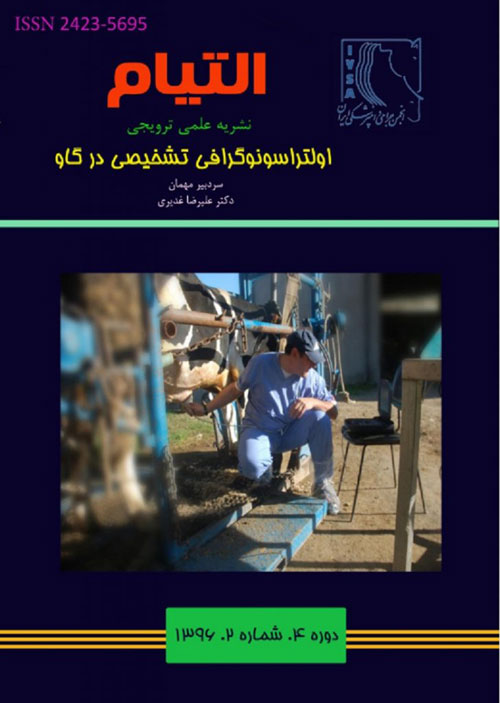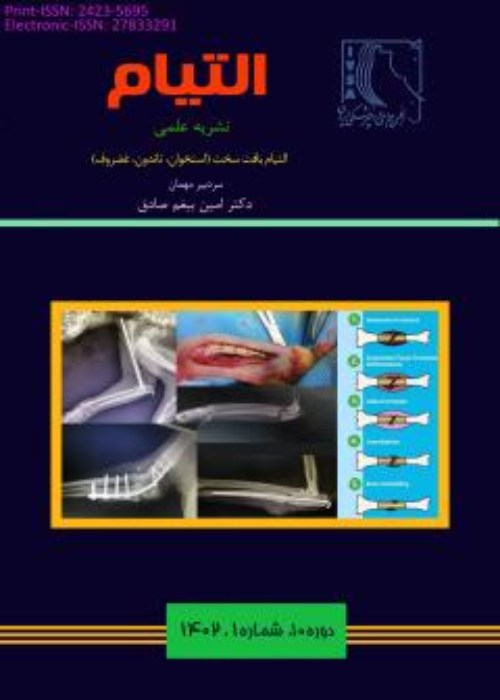فهرست مطالب

نشریه التیام
سال چهارم شماره 2 (پاییز و زمستان 1396)
- تاریخ انتشار: 1396/12/20
- تعداد عناوین: 6
-
-
Page 3In order to manage reproductive production and also to increase the yield of dairy cattle, identifying pregnant and non-pregnant cows is a necessity. A precise examination of the reproductive system for diagnosis of pregnancy, Estimation of embryonic age, examination of pathological and physiological conditions of the reproductive system, it is necessary to manage the herd correctly. Early and correct diagnosis of pregnant and non-pregnant cows, an essential factor for the proper reproductive performance in dairy cows. Ultrasonography of the uterus through the rectum using a 5 MHz linear transducer, a good tool for identifying pregnant and non-pregnant cows from day 22 onwards, after artificial insemination in cattle.Keywords: Cow, Ultrasonography, Pregnancy diagnosis
-
Page 9One of the methods, used today to detect liver parenchyma lesions, liver vessels, bile ducts and gallbladder is ultrasonography. Therefore, this technique is method of choice for diagnosing some of the liver diseases in humans and animals. It is necessary to mention that, any changes in liver tissue, make changes in echogenicity and homogenous appearance of the liver in ultrasonography. Hence, the detection of Space-occupying lesions such as cysts, abscesses tumors, as well as calcified areas are better to detect with ultrasonography, than diffuse lesions, such as hepatitis, fatty liver and hepatic cirrhosis. Ultrasonography in ruminants is the only diagnostic imaging technique which can be used for evaluation of liver in ruminant. It should be mentioned, that in ruminant, most liver diseases are detected only in post-mortem examinations, while, ultrasonography can also be used to diagnose some of liver diseases in clinic.Keywords: Ultrasonography, Live, Gall Bladder, Cattle
-
Page 19Ultrasonography is one of the best and most valuable methods for diagnosing diseases of the urinary tract in humans and animals. The general principles of ultrasonography of the urinary tract in ruminants are similar to those described for humans and small animals. Ultrasonographic technique and normal findings are well described in cattle, sheep and goats. In this article, a review has been made of the normal and abnormal ultrasonographic technique of urinary tract in ruminant, which, can also be used for other domestic and wild ruminants.Keywords: Ultrasonography, Urinary System, Cattle, Sheep, Goat
-
Page 26With the improvement of ultrasound equipment quality and portability, this ancillary test can be used in a farm setting or in hospital. Ancillary tests, such as complete cell blood count and serum biochemistry panel, may lack the sensitivity or specificity to detect heart disease. Diagnosing heart disease in cattle is challenging because clinical signs can be hidden until signs of congestive heart failure occur. An early diagnosis is of primary importance because the prognosis of the most common heart disorders ranges from guarded to poor. This article reviews the techniques, normal and abnormal findings of echocardiography concerning bovine heart.Keywords: Echocardiography, Cattle, Heart
-
Page 39Surgical site infections (SSIs) are among the most common nosocomial infections in human patient. The development of SSI can result in a variety of consequences including poor cosmoses, increased medication costs, revision surgery, prolonged wound management, tissue destruction, risk of drug side effects, increased client cost, and patient death. SSIs can not be completely eliminated, but preventive strategies represent the most economical and effective means of reducing their impact. When SSI does occur, accurate and timely identification of infection, appropriate assessment of the extent of infection, culture based antibiotic therapy, appropriate wound management, and attention to infection control protocols are important to ensure the best outcome. This article will review the classification and definitions of SSI, evaluate patient and environmental risk factors for infection, and explore prevention and treatment strategies.Keywords: Surgical site infections, Small Animal, Prevention
-
Page 47Sixteen adult male New Zealand white rabbits having body weight ranged from 3-3.5 Kg. Under general anesthesia, a segmental full thickness bone defect of 10 mm in length was created in the middle of the right radial shaft in all rabbits. They were divided into two groups of 6 rabbits each. Group I was considered as control and the fractured site was fixed using finger bone plate with 4 screws, whereas the ear cartilage of 1×1 cm graft was used to fill the gap after fracture fixation in Group II. Rabbits in two groups were subdivided into 2 subgroups of 1 and 2 months duration with 4 rabbits in each. Two dimensional and color Doppler sonography was done before and after creating defects and on 15, 30 and 60 days to evaluate local reaction as echogenicity and blood vascular network are concerned. Sonographic findings confirmed the gap in 60 days in Group II hyper echoic with osseous echogenicity, but gap in group I was not hyper echoic with osseous echogenicity and the protrusion of newly formed blood vascular network in 30 days in Group I and from 15 days in Group II and remarkably increased till endof observation period. Cartilage graft is suitable alternative bone filler and two dimensional and color Doppler sonography is reliable techniques to trace local reaction at proper time.Keywords: Cartilage, Sonography, Radial bone


